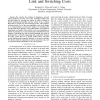Free Online Productivity Tools
i2Speak
i2Symbol
i2OCR
iTex2Img
iWeb2Print
iWeb2Shot
i2Type
iPdf2Split
iPdf2Merge
i2Bopomofo
i2Arabic
i2Style
i2Image
i2PDF
iLatex2Rtf
Sci2ools
ICC
2007
IEEE
2007
IEEE
Network Topology Design to Optimize Link and Switching Costs
—We consider the problem of designing a network which minimizes the total cost of the switching facilities and the fiber links, by choosing the subset of nodes at which to install switching functionality and the subset of the available fiber links to employ for interconnecting nodes. This objective addresses jointly two of the most significant costs in the design of a communications network—the number of switching sites and the total linear distance of the utilized links—and results in substantial cost benefits. Since relative costs vary depending on specific circumstances, we characterize the tradeoff between the number of switching sites and the total link length. Our study is performed for a network supporting full connectivity between all nodes, rather than for a specific traffic matrix, and thus reveals fundamental properties inherent to the given topology. We address both the unprotected and the protected cases, and we present heuristic algorithms to solve the proble...
| Added | 02 Jun 2010 |
| Updated | 02 Jun 2010 |
| Type | Conference |
| Year | 2007 |
| Where | ICC |
| Authors | Benjamin K. Chen, Fouad A. Tobagi |
Comments (0)

